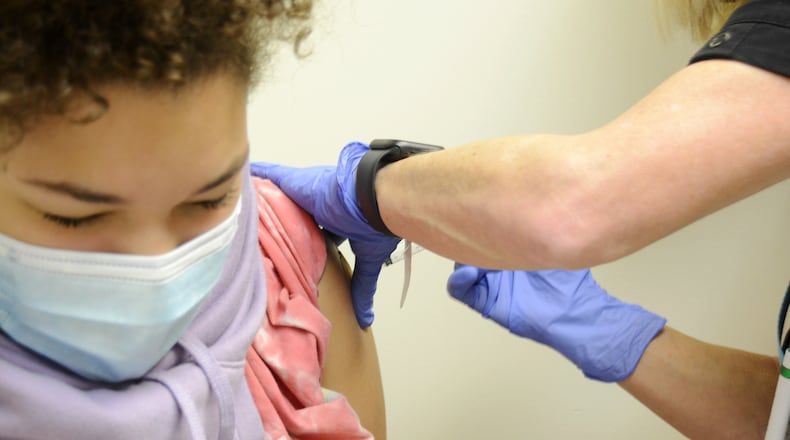The seven school districts the newspaper found with district-wide kindergarten vaccine exemption rates over 10% all serve rural areas.
COVID-19 vaccinations have also nationally been lower in rural areas compared to urban areas with 48% in rural areas versus 61% in metropolitan areas, according to the U.S. Department of Agriculture. The Department of Agriculture noted this difference may have left residents in counties with lower vaccination rates more vulnerable to the Delta variant of coronavirus, which emerged in July 2021.
In Miami County, Newton Elementary School saw a decrease in the percentage of students opted out of immunizations, going from 25.5% in the 2020-2021 school year to 19.7% in the 2021-2022 school year. This is still one of the highest in the region.
Covington Elementary School, also in Miami County, has also fluctuated over the past few school years, exceeding 11% in the 2017-2018 school year before going down and then back up again to 10% in the 2021-2022 school year.
David Larson, superintendent of the Miami County Educational Service Center, discussed the balancing act of seeking the required immunizations but also giving parents the space to make decisions for their families.
“It’s an interesting topic for us to engage in as schools because it’s an additional responsibility that we didn’t necessarily sign up for, and so the challenge comes in where we have to police these decisions that parents are making, and then how that impacts our relationships with families,” Larson said.
“I think we have to be very mindful as school leaders that we can enforce regulations that we’re instructed to enforce, but also make sure parents understand that we respect their rights to make decisions about their kids, and for that matter, respect students’ rights to make decisions when they’re at an age that’s appropriate for them to make decisions on any topic.”
Yellow Springs schools has seen vaccine exemption rates fall steadily since the Dayton Daily News reported that its exemption rate was one of the highest in Ohio. It dropped from 19% in the 2017-2018 school year at Mills Lawn, the village’s only elementary school, to zero kindergarteners with moral exemptions last year.
‘Have open dialogue’
Even prior to the pandemic, the World Health Organization listed vaccine hesitancy as one of the top 10 threats to global health in 2019. The WHO noted a 30% increase in measles cases globally and that countries that were close to eliminating the disease have seen a resurgence.
“It has been escalating, it has been going up,” said Dr. Sara Paton, an associate professor of epidemiology at Wright State University’s Boonshoft School of Medicine, about vaccine hesitancy. “It’s actually been a really big concern.”
In order to achieve herd immunity, which is the resistance to the spread of contagious diseases due to a pre-existing immunity a portion of a population has, there needs to be higher percentages of the population immunized against diseases that spread more easily. To prevent the spread of polio, Paton said you need around 80% of the population to be immunized against it. For the measles, though, it needs to be around 95%.
“It’s easily transmissible,” Paton said.
Health departments are working with families to fill in vaccination gaps.
“We work closely with all school districts, especially Springfield City, as well as Rocking Horse Community Health Center to ensure that parents that want to have their children vaccinated have a clear avenue to reach those goals,” said Charles Patterson, health commissioner with the Clark County Combined Health District.
“We’re doing outreach for our children who maybe need to get caught up on vaccines,” said Jennifer Wentzel, Montgomery County health commissioner with Public Health - Dayton and Montgomery County. “We have open walk-in hours, and those have been a huge success.”
Health officials and educators recommend districts keep lines of communication open with parents and guardians when it comes to vaccinations.
“What I would recommend is districts have open dialogue with parents, and make sure they are providing opportunity for families to share what their concerns are, share their beliefs,” Larson said. “I think it’s an opportunity for good, meaningful discussion, which I think can build strong relationships with our parents and families and communities.”
Creating environments for positive conversations are important, Larson said, especially when individuals are divided.
“If you look at the last few years, people in general I think have just become very defensive and maybe feel as though their opinions aren’t appreciated or respected,” Larson said. “We can disagree about something or recommend a different direction and still be respectful.”
About the Author


